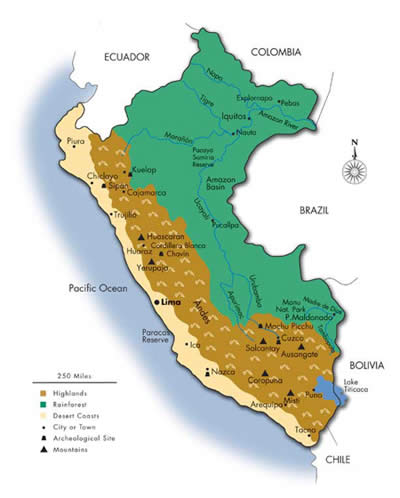|
Peru
ranks amongst the world's great centers of
ancient civilization. Their remains fascinate
travelers and archaeologists alike. Peru is
located in the west central part of South
America and is a country of geographical and
cultural contrast. Peru is the 19th largest
country in the world and is bordered north by
Ecuador, to the south by Chile and Bolivia, to
the east by Columbia and Brazil and to the west
by the Pacific Ocean. Peru is a diverse country
due to the climatic, natural and cultural
variation of it s regions, which include
coast,
sierra and
jungle. s regions, which include
coast,
sierra and
jungle.
Peru is populated by over 23 million people,
largely descendents of Spanish settlers and
native Inca and pre-Inca cultures. Today there
are three national languages: Spanish, and the
native Quechua and Aymara, reflecting the native
Indian and Spanish roots that cultivate modern
Peruvian society.
GENERAL PERU
INFORMATION. PERU FACTS.
Population: 23 million, approximately 7 million
live in the greater
Lima Peru area.
Education and Literacy: Three-level, eleven-year
education system based on reforms made after the
1968 revolution. First preprimary level for
children up to six years of age. Free, six-year
primary education at second level (compulsory)
for children between six and fifteen years of
age. Five-year secondary education begins at age
twelve. In 1990, only 58.6 percent of school-age
children attended school. At this time, Peru had
twenty-seven national and nineteen private
universities, all government-regulated and
recipients of public funding. The estimated
literacy rate in Peru is 85%.
Health:
Peru's health indicators are poor, with annual
public health expenditure per capita of US$18 in
1990. In 1992 birth rate 27 births per 1,000
population; infant mortality rate 69 per 1,000
live births; life expectancy 63 years male, 67
years female. Over 25% of urban residences and
over 90% of rural residences lacked potable
water and sewerage, resulting in high death
rates from infectious diseases. In 1991 about
1,200 died weekly from malnutrition and extreme
poverty, while 38% of the survivors suffered
chronic malnutrition. Total of 22,000 physicians
in 1991. In 1992, abortion was considered one of
the primary health threats for Peruvian women.
43% of all maternal hospitalizations in Peru
resulted from botched abortions. Abortion is
illegal in Peru. Peru travel Agency
is the perfect choice to enjoy an unforgettable
experience.
Religion:
Peru is predominantly
(92.5%) Roman Catholic, Protestantism, including
Mormonism growing rapidly among urban poor and
some tribes, although accounting for only about
4.5% of Peruvians in 1990. Other denominations
include the Anglican Communion; the Methodist
Church; and the Bahai Faith.
we have the best promotional travel packages for you to enjoy an
unforgettable holiday. |
